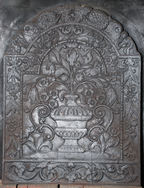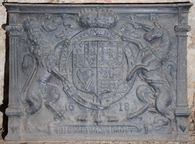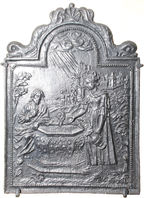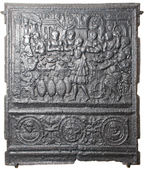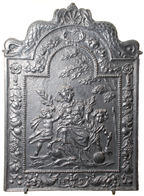-
516
Description: Arched rectangular central panel with bead-and-pellet edging; on a ground between two plants, a gadrooned flower vase with two, scrolled handles, tulips and other flowers issuing from the narrow neck; arched rectangular border with fillet edging; mirrored descending flower swags; along a rectangular bottom panel with fillet edging a symmetrical arrangement of swirled foliage; on top, two mirrored sea serpents.
Notes: The presence of tulips suggest a Dutch origin for the pattern of this fireback, although the presence of several examples in England suggest that it was produced here rather than on the Continent.
Copies of this fireback are known.
- Decoration tags:
- 'Dutch' (shape)
- fillet (edging)
- whole carved pattern
- planklines
- pictorial
- plants
- objects
Manufactured: in the late-17th century in England.
Current location: Penshurst Place, Penshurst, Kent, England.
- Attached to series:
- Flower Vase 'Dutch' types
- British 'Dutch' style firebacks
-
517
Description: Rectangular; ogee within broad fillet moulded edging; top centre, date between split initials, with small diamonds between date and initials and outside initials.
Inscription: T 1665 S
- Decoration tags:
- rectangular (shape)
- fillet and ogee (edging)
- text
Manufactured: in 1665 in the Weald area of England.
Current location: Penshurst Place, Penshurst, Kent, England.
- Attached to series:
- Date & initials firebacks
-
519
Description: Rectangular; Ionic pilasters at sides, architrave on top; English Stuart royal shield, garter, crown, motto and supporters; date below and either side of garter.
Notes: One of several firebacks, all of the same date, but varying in size, framing style and moulding; all have stylistic features in common and will have been the work of the same pattern maker, who was also responsible for carving royal coats of arms in three West Country churches. A plaster cast of a fireback of this design is displayed as the royal arms in St George's church, near Abergele in north Wales.
Copies of this fireback are known.
Inscription: HONI SOIT QVI MAL Y PENSE / 16 18 / DIEV ET MON DROIT
Arms: English Stuart royal (James I)
- Decoration tags:
- rectangular (shape)
- complex individual (edging)
- whole carved pattern
- armorial
- royal
- text
Manufactured: in 1618 possibly in the Forest of Dean area of England.
Current location: Penshurst Place, Penshurst, Kent, England.
-
545
Description: Arched rectangular central panel with canted top corners and bead-on-fillet edging; pictorial scene of Jesus at the well with the woman of Samaria; arched rectangular border with fillet edging; on top, central scallop shell with a descending dolphin on each side of the arch.
Notes: A scene from the New Testament - John 4.
Copies of this fireback are known.
Manufactured: in the mid- to late-17th century in the Siegerland area of Germany.
Current location: Petworth House, Petworth, West Sussex, England.
Museum number: NT/PET/M/100 (part of the National Trust museum group)
- Attached to series:
- 'Dutch' Miscellaneous Firebacks
- New Testament firebacks
-
546
Description: Rectangular; ovolo edging; shield, helm, crest, mantling and motto of the Merchant Taylors’ Company: Argent a Pavilion Imperial Purple garnished Or lined Ermine between two Mantles also Imperial Purple lined Ermine on a chief Azure a Lion passant guardant Or.
Notes: Arms were re-granted to the Company in 1586; the excrescences on the helm and shield are probably the result of splashes caused when pouring the iron into the mould from too great a height.
Inscription: CONCORDIA PARVAE RES CRESCUNT [In Harmony Small Things Grow]
Arms: Worshipful Company of Merchant Taylors
- Decoration tags:
- rectangular (shape)
- ovolo (edging)
- whole carved pattern
- armorial
- text
Manufactured: in the late-16th to early-17th century possibly in the Weald area of England.
Current location: Petworth House, Petworth, West Sussex, England.
Museum number: NT/PET/M/101 (part of the National Trust museum group)
- Attached to series:
- Livery company firebacks
-
548
Description: Arched rectangular central panel with bead edging; female figure, a crown above her head, holding two snakes; arched rectangular border with fillet edging; top centre, knot of ribbon with festoons of pomegranates suspended therefrom via a ring on each shoulder of the plate; at the bottom, two crossed palm fronds; on top, symmetrical arrangements of swirled foliage; on each side, a plain rectangular panel with fillet edging.
Notes: Possibly the allegorical figure of Democracy; the form of the palm fronds and the swirled foliage on top suggest a common pattern-maker with the TAN series and the Mayfield 'Dutch' series.
- Decoration tags:
- 'Dutch' (shape)
- fillet (edging)
- whole carved pattern
- extension panels
- pictorial
- allegorical
- humans
Manufactured: in the early-18th century in England.
Current location: Petworth House, Petworth, West Sussex, England.
Museum number: NT/PET/M/102 (part of the National Trust museum group)
- Attached to series:
- British 'Dutch' style firebacks
- TAN series
-
547
Description: Rectangular with flanged edging; upper rectangular panel with cyma recta edging; pictorial scene of the Marriage at Cana; lower rectangular panel with fillet edging; three circular medallions with twin, concentric fillet edges, the left one with the bust of male, the right one with the bust of a female and the centre one with a floral design.
Notes: The scene is from the New Testament - John 2.
- Decoration tags:
- rectangular (shape)
- flanged (edging)
- whole carved pattern
- planklines
- pictorial
- biblical
- humans
Manufactured: in the late-16th to early-17th century possibly in the Eifel area of Germany.
Current location: Petworth House, Petworth, West Sussex, England.
Museum number: NT/PET/M/103 (part of the National Trust museum group)
- Attached to series:
- Stoveplates
- Marriage at Cana stoveplates
-
551
Description: Rectangular; ovolo-moulded edging; top centre, stamp formed of a carved domestic scene of a family around a table, between two small mirrored rectangular stamps each of a cow; lower centre, symmetrical arrangement of two jugs, two goblets and two crossed churchwarden pipes, all in low relief.
Notes: The domestic group has been formed from a decorative iron mantelpiece ornament portraying the tale of the goose that laid golden eggs. Having killed the goose, the family are lamenting the loss of their bounty (see Ames, 1980, p.94). The style of the fireback suggests a pastiche using designs suggesting the past. The same mantelpiece group can be seen as decoration on the kitchen spit assemblage at Petworth House, West Sussex, which was cast at Robert Chorley's foundry at Cocking, south of Midhurst. Evidently this and another fireback bearing the same ornament stamp were among items from the Cowdray estate sold in 1898.
- Decoration tags:
- rectangular (shape)
- ovolo (edging)
- carved stamps
- animals
- humans
- objects
Manufactured: in the early-19th century probably at Cocking Foundry in the Weald area of England.
Current location: Petworth House, Petworth, West Sussex, England.
Museum number: NT/PET/M/43 (part of the National Trust museum group)
Citation: Ames, A., 1980, Collecting Cast Iron (Ashbourne, Moorland Publishing).
- Attached to series:
- Cocking foundry firebacks
- Ornament stamp firebacks
- Metalware stamp firebacks
-
553
Description: Arched rectangular shape; bead-on-fillet edging; standing figure of a female holding a torch in her right hand, a goat by her feet, and a bush bottom left; arched rectangular border with ovolo-moulded edging; symmetrical arrangement of scrolled foliage; on top, a scallop shell with a descending dolphin on each side of the arch.
Notes: The figure is an allegorical representation of Wisdom.
- Decoration tags:
- 'Dutch' (shape)
- ovolo (edging)
- whole carved pattern
- pictorial
- allegorical
- humans
Manufactured: in the mid- to late-17th century possibly in the Siegerland area of Germany.
Current location: Petworth House, Petworth, West Sussex, England.
Museum number: NT/PET/M/45 (part of the National Trust museum group)
- Attached to series:
- 'Dutch' tall arch series
-
554
Description: Arched rectangular central panel with bead-on-fillet edging; pictorial scene of a seated female holding a small child, with two putti, one on each side of her, the one on her right holding an olive branch, the one on her left holding a flaming heart, his foot aginst a globe; arched rectangular border with fillet edging; top centre, laurel wreath from which descend festoons of flowers and fruit suspended from roses; at the bottom, a cartouche containing the intials between two cornucopiae; on top, a scallop shell between two descending dolphins.
Notes: The group is an allegorical representation of Charity
Copies of this fireback are known.
Inscription: H S
- Decoration tags:
- 'Dutch' (shape)
- fillet (edging)
- whole carved pattern
- pictorial
- allegorical
- text
- humans
Manufactured: in the mid- to late-17th century in the Siegerland area of Germany.
Current location: Petworth House, Petworth, West Sussex, England.
Museum number: NT/PET/M/46 (part of the National Trust museum group)
- Attached to series:
- 'Dutch' Miscellaneous Firebacks
- Charity firebacks
